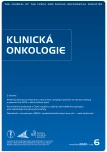Practical instructions for testing and targeted therapy in adult patients with solid tumours with NTRK gene fusion in common clinical practice
Authors:
Tomáš Büchler 1; Pavel Dundr 2; Jindřich Fínek 3; Igor Kiss 4; Radoslav Matěj 5,6; Bohuslav Melichar 7; Michal Michal 8,9; Luboš Petruželka 10
Authors‘ workplace:
Onkologická klinika 1. LF UK a Thomayerovy nemocnice, Praha
1; Ústav patologie, 1. LF UK a VFN v Praze
2; Onkologická a radioterapeutická klinika FN Plzeň
3; Klinika komplexní onkologické péče MOÚ Brno
4; Oddělení patologie a molekulární medicíny, Thomayerova nemocnice, Praha
5; Ústav patologie, FN Královské Vinohrady, Praha
6; Onkologická klinika FN Olomouc
7; Šiklův ústav patologie, FN Plzeň
8; Bioptická laboratoř s. r. o., Plzeň
9; Onkologická klinika 1. LF UK a VFN Praha
10
Published in:
Klin Onkol 2020; 33(6): 414-419
Category:
Review
Overview
Background: Tropomyosin receptor kinase inhibitors (TRKi) have been shown to produce a dramatic and long-lasting effect on tumours harbouring fusions of neurotrophic receptor tyrosine kinase (NTRK) genes. Due to the low incidence of these molecular aberrations in common types of solid adult tumours, the identification of patients eligible for the treatment with TRK inhibitors in routine clinical practice is a major challenge. The current methods for NTRK gene fusion testing include immunohistochemistry (IHC), fluorescence in situ hybridization (FISH), and several genomic assays using next-generation sequencing (NGS). After considering the characteristics of these tests, we recommend two-step testing for clinical practice in tumours with a low incidence of NTRK gene fusions. In the first step, a fresh or archival formalin fixed paraffin embedded (FFPE) sample is tested using a validated IHC method. If the IHC result is positive, verification using RNA-based should follow, preferably using fresh tissue sample. If fresh tissue biopsy cannot be obtained, e. g. due to a disproportionate risk or discomfort for the patient, an archival FFPE sample may be used for testing. For tumours with high incidence of NTRK gene fusions, we recommend upfront NGS sequencing. Larotrektinib is currently the only TRK inhibitor registered in the EU. Although entrektinib, another TRK inhibitor, is not yet registered in the EU, it is currently available in the Czech Republic within an Early Access Programme. Purpose: The aim of this paper is to provide concise and clear guidance on testing for the presence of NTRK gene fusions and indications for the treatment with TRK inhibitors in the routine clinical oncology practice.
Keywords:
neurotrophic receptor kinase – targeted molecular therapy – entrektinib – larotrektinib – neoplasms
Sources
1. Penault-Llorca F, Rudzinski ER, Sepulveda AR. Testing algorithm for identification of patients with TRK fusion cancer. J Clin Pathol 2019; 72 (7): 460–467. doi: 10.1136/jclinpath-2018-205679.
2. Hsiao SJ, Zehir A, Sireci AN et al. Detection of tumor NTRK gene fusions to identify patients who may benefit from tyrosine kinase (TRK) inhibitor therapy. J Mol Diagn 2019; 21 (4): 553–571. doi: 10.1016/j.jmoldx.2019.03.008.
3. Skálová A. Jak testovat fúze NTRK v éře pan-TRK inhibitoru: incidence, indikace a technologie. [online]. Dostupné z: https: //www.prolekare.cz/tema/precizni-medicina/detail/jak-testovat-fuze-NTRK-v-ere-pan-trk-inhibitoru-incidence-indikace-a-technologie-112656.
4. Yoshino T, Pentheroudakis G, Mishima S et al. JSCO-ESMO-ASCO-JSMO-TOS: international expert consensus recommendations for tumour-agnostic treatments in patients with solid tumours with microsatellite instability or NTRK fusions. Ann Oncol Off J Eur Soc Med Oncol 2020; 31 (7): 861–872. doi: 10.1016/j.annonc.2020.03.299.
5. SPC Vitrakvi. [online]. European Medicines Agency (EMA) 2019. Available from: https: //www.ema.europa.eu/en/documents/product-information/vitrakvi-epar-product-information_cs.pdf.
6. Hong DS, DuBois SG, Kummar S et al. Larotrektinib in patients with TRK fusion-positive solid tumours: a pooled analysis of three phase 1/2 clinical trials. Lancet Oncol 2020; 21 (4): 531–540. doi: 10.1016/S1470-2045 (19) 30856-3.
7. Solomon JP, Linkov I, Rosado A et al. NTRK fusion detection across multiple assays and 33,997 cases: diagnostic implications and pitfalls. Mod Pathology 2020; 33 (1): 38–46.
8. Chen Y, Chi P. Basket trial of TRK inhibitors demonstrates efficacy in TRK fusion-positive cancers. J Hematol Oncol 2018; 11 (1): 78. doi: 10.1186/s13045-018-0622-4.
9. Lasota J, Chlopek M, Lamoureux J et al. Colonic adenocarcinomas harboring NTRK fusion genes: a clinicopathologic and molecular genetic study of 16 cases and review of the literature. Am J Surg Pathol 2020; 44 (2): 162–173. doi: 10.1097/PAS.0000000000001377.
10. Vaňková B, Vaněček T, Ptáková N et al. Targeted next generation sequencing of MLH1-deficient, MLH1 promoter hypermethylated and BRAF/RAS-wild-type colorectal adenocarcinomas is effective in detecting tumors with actionable oncogenic gene fusions. Genes Chromosom Cancer 2020; 59 (10): 562–568. doi: 10.1002/gcc.22861.
11. Drilon A, Laetsch TW, Kummar S et al. Efficacy of larotrektinib in TRK fusion-positive cancers in adults and children. N Engl J Med 2018; 378 (8): 731–739. doi: 10.1056/NEJMoa1714448.
12. Laetsch TW, DuBois SG, Mascarenhas L et al. Larotrektinib for paediatric solid tumours harbouring NTRK gene fusions: phase 1 results from a multicentre, open-label, phase 1/2 study. Lancet Oncol 2018; 19 (5): 705–714. doi: 10.1016/S1470-2045 (18) 30119-0.
13. Hong DS, Bauer TM, Lee JJ et al. Larotrektinib in adult patients with solid tumours: a multi-centre, open-label, phase I dose-escalation study. Ann Oncol 2019; 30 (2): 325–331. doi: 10.1093/annonc/mdy539.
14. Rozlytrek Prescribing Information. [online]. Food and Drug Administration 2019. Available from: https: //www.accessdata.fda.gov/drugsatfda_docs/label/2019/212725s000lbl.pdf.
15. Doebele RC, Drilon A, Paz-Ares L et al. Entrektinib in patients with advanced or metastatic NTRK fusion-positive solid tumours: integrated analysis of three phase 1-2 trials. Lancet Oncol 2020; 21 (2): 271–282. doi: 10.1016/S1470-2045 (19) 30691-6.
16. Společné stanovisko VZP ČR, SZP ČR, ČHS ČLS JEP a SČP ČLS JEP: Doporučené podmínky pro nasmlouvání a provádění výkonu 94365 – analýza sekvenace lidského somatického genomu technologií sekvenace nové generace (NGS) 2019. [online]. Dostupné z: https: //media.vzpstatic.cz/media/Default/dokumenty/spolecne-stanovisko-vzp-cr-szp-cr-chs-cls-jep-a-scp-cls-jep-k-vykonu-94365.pdf.
Labels
Paediatric clinical oncology Surgery Clinical oncologyArticle was published in
Clinical Oncology

Most read in this issue
- Immunostimulatory and anticancer effect of Reishi and Coriol extracts at the level of clinical studies and their implementation in practice
- First experience in the Czech Republic with perirectal hydrogel injection before radiotherapy for prostate cancer
- Stomatitis in mTOR inhibitors treatment and other targeted cancer therapy, possibilities of infl uencing it, and the use of local corticotherapy
- Treatment opinion of rehabilitation in sarcopenia and cachexia for oncological patients
